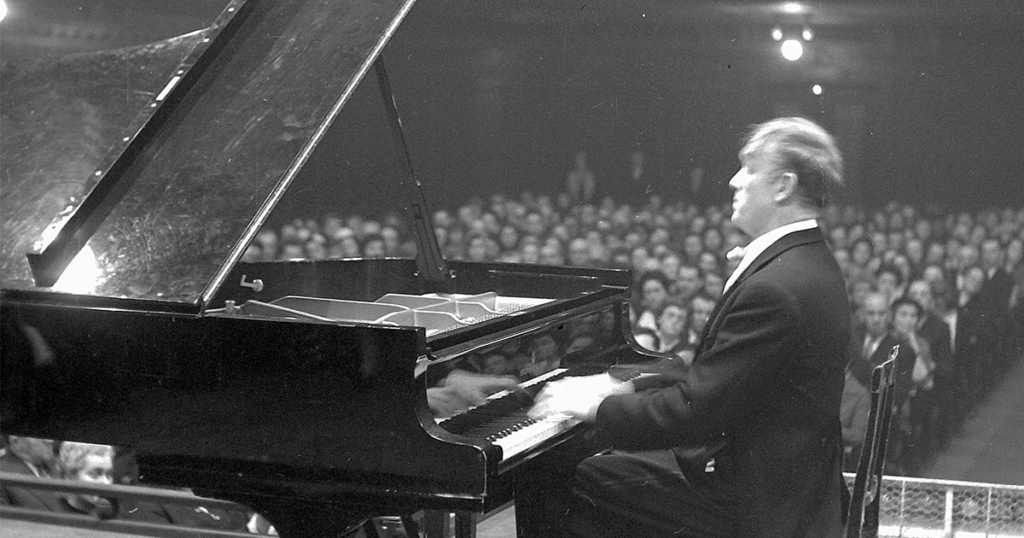
Twenty years ago in August, the pianist Sviatoslav Richter suffered a heart attack at the age of 82 and died in a Moscow hospital. Richter was many things—a master virtuoso, an enigmatic personality, a supreme colorist capable of summoning forth from the keyboard an astonishing range of hues and shades. He was also a cultured and cultivated artist whose keen intelligence penetrated a repertoire ranging from Bach to Chopin, Beethoven to Rachmaninov, Debussy to Prokofiev. One composer, however, seemed to occupy a special place in Richter’s heart, as anyone attending the pianist’s funeral might have noticed. There, in the spacious 16th-floor apartment on Bolshaya Bronnaya Street that he shared with his wife, the Olympian artist lay in repose, his coffin placed before his two pianos. On one of those pianos was a single score: a piece by Franz Schubert.
Nobody played Schubert like Richter. I could bring up any number of felicities—his sense of narrative and structure, his exquisite touch, the attention he paid to the most innocuous detail, the way his interpretations of the standard repertoire seemed at once controlled and improvisatory—but when I think of Richter’s Schubert, one thing comes to mind first: tempo. Slow tempos, glacial tempos, tempos that make no sense on paper, but that, when heard, transport the interpretations into visionary terrain. The most famous example perhaps is Schubert’s Piano Sonata D. 960, the last he ever wrote. The first time I heard this piece, a little more than two decades ago, it was on a recording of Richter’s, made at the 1964 Aldeburgh Festival, on England’s Suffolk coast. The playing of the first movement was unlike anything I’d listened to before. It unfolded at a pace so slow as to strain credulity. Ordinarily, you’d snuff the life out of a musical line by reducing its speed by half, but strangely, with Richter, nothing at all seemed labored. Indeed, once I began to surrender to the music on the pianist’s terms, the effect was magical and mesmerizing. Like Sergiu Celibidache in his cosmic readings of the Bruckner symphonies, Richter was creating a world in which physical law had been seemingly altered—time and space were not as they had appeared before. The inner voices emerged with poignant urgency, and though the phrasing and dynamics were almost mathematically calibrated, the musical lines nevertheless had freedom. The piece breathed. Have you heard this astonishing interpretation? I would ask the very few friends of mine who might have cared, pushing the CD upon them like some fevered evangelist. After Richter’s, every other recording of this sonata seemed pedestrian, thin, unremarkable, and it’s taken many years for me to realize how wrong I’d been—not about Richter, but about everyone else; I have since come to admire the interpretations of Alfred Brendel, Clifford Curzon, Richard Goode, Mitsuko Uchida, and others.
Richter was famously averse to the studio, so most of his great Schubert recordings were made in concert. Two recent sets provide an opportunity to hear how his interpretations evolved—the first a 10-disc compilation on the Profil label, covering Richter’s earliest performances (dating from 1948 to 1963), the second a four-CD set from the Russian company Melodiya, which includes tapes from the late 1970s. Lately, both have provided me with hours of pleasure, but if there’s one piece among this abundance of riches that I keep returning to, it’s the Sonata in G Major D. 894. This was Richter’s favorite Schubert sonata, and it happens to be mine, as well.
Richter recorded the work in the Great Hall of the Moscow Conservatory on May 2, 1978, and here again is a reading for the ages, with a tempo that at first seems impossibly slow but that delineates a space governed by its own logic. Those opening pages conjure up a vast and placid expanse, the theme almost inexpressibly beautiful when played at so stately a tempo. The first movement is marked Molto moderato e cantabile—that is, very moderately paced, and with a singing quality. This isn’t moderato by any sense of the term, but rather adagio or perhaps lento, but as a result of this elongation, you can hear every detail—all the inner voices, as well as the slightest of ornamental gestures, now imbued with deep significance. For much of this movement, Richter guides us into a realm of preternatural calm, but then, the music turns turbulent, and after page upon page of tightly controlled dynamics, rarely rising above mezzo forte, Richter unleashes great torrents of sound; it’s as if the heavens have opened up, and the weighty sonorities, so intense, so leonine, become almost too much to bear. The rest of the sonata is remarkable, too—the last movement, for example, characterized by innocence, charm, and wit, has an underlying feeling of agitation, given how Richter attacks the repeated eighth note figures in the left hand—yet it’s the sprawling first movement that I can’t get out of my head. Richter had finesse, refinement, and intelligence in spades, but listen to his Schubert, and you’ll know that he also had soul.

